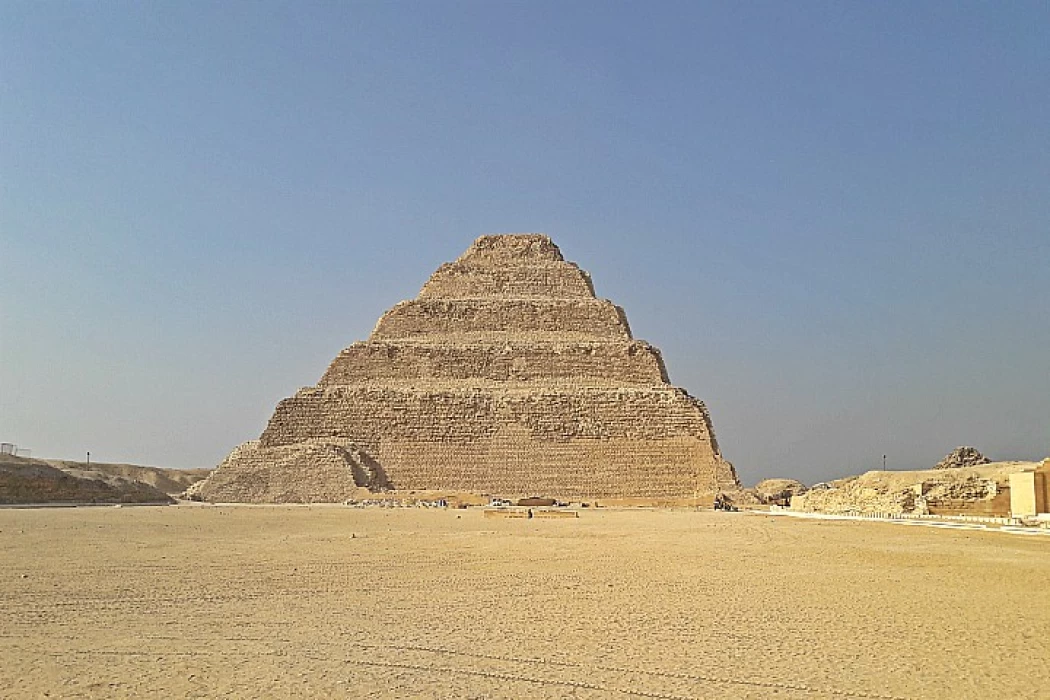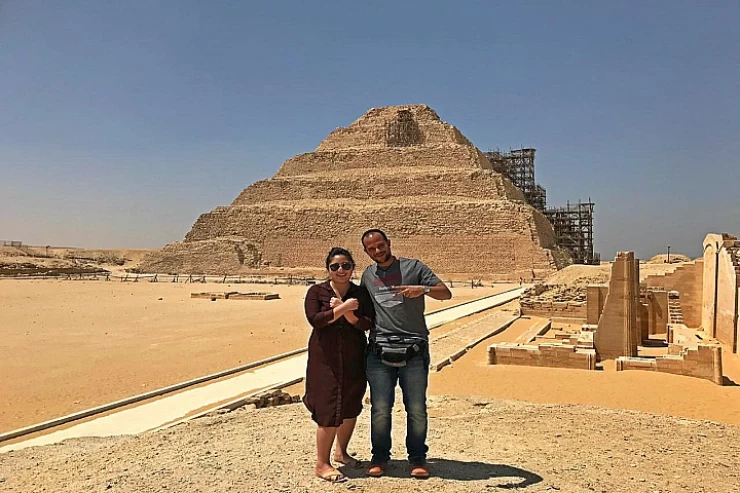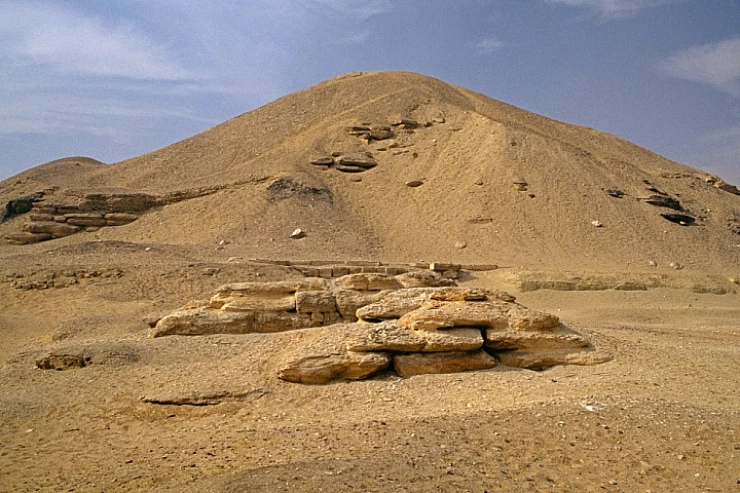
埃及最古老的金字塔
探索萨卡拉的古代奇迹: 埃及第一座金字塔群之旅
萨卡拉位于开罗西南部,濒临沙漠,是古埃及历史上一个值得骄傲的地方,也是埃及考古遗址之一。众所周知,这片广袤的土地是孟菲斯城墓地的延伸。萨卡拉有许多有趣的建筑,其中一些已经存活了 4700 多年,里面有法老、贵族甚至神圣宠物的坟墓。该地区最有名的建筑是乔瑟阶梯金字塔,它被称为第一座真正意义上的金字塔,也被认为是该地区同类建筑中最大的石制建筑。
因此,本文试图研究萨卡拉的历史意义、主要地标以及这座古城的美景。
萨卡拉简史
萨卡拉的历史意义可以追溯到公元前 2650 年左右的埃及第三王朝,当时法老朱塞下令建造金字塔群。由传奇建筑师伊姆霍特普设计的阶梯金字塔是建筑技术的一次变革,从普通的泥砖平顶墓室转变为装饰松石建筑。随着时间的推移,萨卡拉发展成为一个大型墓葬区,其中包含古埃及历史上不同朝代和时代的墓葬,这些朝代和时代包括旧王国、中王国、新王国,甚至后期。
萨卡拉与孟菲斯的其他地方及其墓地(联合国教科文组织世界遗产)一样,在考古学和历史学方面都具有重要意义。由于遗址中存在许多金字塔、桅杆、神庙和墓葬群,它还解释了埃及人埋葬死者方式的演变、其中涉及的宗教因素,甚至几个世纪以来的结构发展。
乔瑟阶梯金字塔: 建筑奇迹
毫无疑问,萨卡拉最重要的特征就是乔瑟尔的阶梯金字塔--这是有史以来建造的第一座金字塔,也是埃及辉煌的绝妙体现。这座金字塔高约 62 米,由六个逐渐缩小的阶梯组成,使金字塔呈现出常见的阶梯形状。贞节牌坊的建筑师是第一个在宏伟建筑中使用石块的人,他镶嵌的石板后来发展成为吉萨真正的金字塔。
环绕金字塔本身的是一系列庭院、庙宇和其他宗教建筑,其中大部分都是为国王来世造福而设计的。其中包括南院,游客可以在南院看到几座古代神龛和祭坛的遗址,这些神龛和祭坛用于祭祀目的。建筑群周围有一道巨大的院墙,共有 14 扇门,其中一扇门用于功能性目的,代表国王最后的安息之地,不受外界干扰。
在阶梯式金字塔结构中,有一个由楼梯和房间组成的老鼠窝。虽然主墓室在古代被盗,但考古学家还是发现了大量有助于了解古埃及文化和习俗的物品和贵重物品。
萨卡拉古墓:隐藏的埃及艺术瑰宝
除了萨卡拉的阶梯金字塔,这里还有许多高级官员、贵族和王室成员的墓葬。这些古埃及墓葬装饰着精美的雕刻图像和壁画,展示了古埃及生活的方方面面,包括日常活动、宗教习俗和图腾。
梅勒鲁卡的马斯塔巴
梅勒鲁卡马斯塔巴(La Mastaba di Mereruka)是萨卡拉古墓中另一座引人注目的古墓。这是古墓群中规模最大、装饰最华丽的墓葬之一。梅勒鲁卡是法老泰提的女婿。他的陵墓包含数量惊人的房间,多达 32 个墓室,墓室的墙壁上布满了质量上乘的浮雕图像。这些图像所描绘的事件详细展现了古埃及文明的许多方面,从医疗实践和宗教仪式到休闲和家务。
塞拉佩姆:阿庇斯公牛的埋葬地。
萨卡拉的塞拉佩姆(Serapeum)是另一个有趣的方面,它主要是为埋葬化身为普塔神(Ptah)的神牛(Apis)而建造的。塞拉佩姆由一系列地下走廊和长廊组成,里面有大型石棺,用来安葬神牛的遗骸。这个建筑群体现了古埃及人对动物的热爱以及他们对某些动物神化的独特信仰。
提墓
提墓是萨卡拉地区比较著名的墓葬之一。提是第五王朝时期的高级政府官员。这座古墓以其复杂的浮雕而闻名,浮雕上的逖活跃于日常活动中,如侍弄庄稼、出海捕鱼、向神灵供奉祭品等。这些图像不仅精美,而且非常有助于了解古王国的社会、经济和文化。
萨卡拉的新发现 揭开古老的秘密
萨卡拉仍然是一个活跃的考古研究和勘探地点,新的发现有助于了解古埃及文明中以前不为人知的部分。近年来发掘了从古王国到晚期不同时期的坟墓、棺木和大量文物。
新王国第五代祭司 Wahtye 的坟墓是一座不朽的坟墓,保存非常完好,墓中有精美的壁画,展示了上述祭司的生活和宗教活动。另一个重要发现是一批石棺和人形木棺,其中大部分都有装饰,有些甚至是封闭的,并涂有清漆。这些出土文物不仅有助于更深入地了解萨卡拉地区的历史,而且揭示了萨卡拉作为考古遗址的重要性,即使在今天也是如此。
游览萨卡拉: 旅行者实用信息
对于那些想要游览萨卡拉的人来说,这个地方可以说是一次暂时的探险,也是埃及一些奇妙历史遗迹的宝藏。请允许我们与您分享一些有用的信息,希望对您的游览有所帮助:
如何前往 萨卡拉距离开罗市中心约 30 公里,位于开罗西南部,驾车前往非常方便。许多旅游团都包含参观萨卡拉的行程,其中大多数旅游团还会参观附近的其他景点,如吉萨金字塔和达舒尔地区。
穿戴:由于萨卡拉位于沙漠中,所以一定要穿上合适的衣服,戴上帽子,并用防晒霜保护皮肤。最好穿一双好的步行鞋,因为有些地方的地面可能崎岖不平。
导游: 尽管没有导游的帮助也可以游览萨卡拉,但积极的一面是,导游确实有助于改善游览体验。丰富的导游有助于丰富背景和事实,使古老的历史和遗址的重要性不再平淡无奇。
其他景点: 您还可以参观距离萨卡拉不远的其他景点,例如戴维斯金字塔、弯曲金字塔、红金字塔和孟菲斯,它们都位于萨卡拉附近。
结束语 萨卡拉的永恒遗产
说萨卡拉在古埃及历史上很重要,只是轻描淡写。它的故事是多方面的:它是金字塔建筑的发源地,三千多年来一直被用作神圣的埋葬地。
萨卡拉拥有一些最具革命性的建筑,从乔瑟尔的阶梯金字塔到装饰华丽的神庙壁龛,它们揭示并保存了古埃及的创造力、宗教信仰和悠久的历史。
据说,在萨卡拉,人们不仅能体验到过去的美好时光,还有机会像法老一样践踏历史。萨卡拉是一个如此令人着迷的地方,几乎所有历史爱好者和渴望了解埃及古代奇迹的普通人都会不约而同地来到这里。它依然令人叹为观止、神秘迷人,充满了永恒之美。
游览提示: 不走寻常路
阶梯金字塔是人们关注的焦点,大多数游客都会参观这座金字塔。然而,在更大的萨卡拉墓地中,还有更多令人惊叹但游客较少的景点,可以静下心来欣赏。参加一个集中参观较小的、不太受欢迎的陵墓和地狱的旅游团,可以让您对感兴趣的地区有更多的了解。另外,您也可以考虑在清晨或傍晚前往这些景点,此时光线洒在古老的石头上,美轮美奂,拍出的照片也不易被忽视。
在萨卡拉,人们会不由自主地看到和感受到,他们正在进入一个完整的古埃及文明,一个非同寻常的地方,在这里,每一座建筑或每一件物品都可以讲述上百段历史。这是一个地方,也是一个历史时刻,在这里,风沙经过一段时间的侵蚀,保留了古埃及的美丽,而人们就站在这个文明最初的国王、王后甚至宠物中间。
尽管埃及是一个略显传统的国家,但建议游客最好穿着得体、休闲的服装。
为了避免上述问题,您可以采取以下实际措施:
1. 传感器袖口
无论男女,最好都有能遮住肩膀、胸部和膝盖的衣服。穿长裤或长裙和有袖子的上衣。
出于对文化的尊重,最好不要戴牛仔帽、穿短裤和吝啬的服装。
2. 轻便舒适的织物
萨卡拉地处沙漠地带,因此热量会让人难以忍受,主要是在炎热的时候。建议穿着轻便透气的织物,如棉布和亚麻布。
此外,穿着鲜艳的衣服有助于反射阳光,使人更加凉爽。
3. 防晒
最重要的携带物品之一是宽边帽、太阳镜和大量防晒霜,尤其是在树荫较少的空旷地区。
在这种情况下,围巾或披肩会很有用,尤其是在阳光非常强烈的气候条件下,或者对于那些喜欢把肩膀遮起来的人来说。
4. 破旧的步行鞋
萨卡拉的路面崎岖不平,而且充满了沙子;因此,强烈建议穿上适当绑带和缓冲的步行鞋。
相反,应避免穿凉鞋和拖鞋,因为它们对脚没有任何保护或支撑作用。
据了解,没有固定的 “着装要求 ”需要遵守;但是,穿着宽松和尊重当地文化的衣服将确保您保持舒适,并能够尽可能地享受在萨卡拉的时光。
To the southwest of Cairo and on the verge of the desert, there exists Saqqara, a design that can boast a lot about ancient Egyptian history, thus making it one of the archaeological sites. This vast expanse is known to be the extension of the burial grounds of Memphis City. Saqqara bears many interesting structures; some of them have managed to survive for more than 4700 years, containing tombs of the pharaohs, nobles, and even sacred pets. The most famous structure in the area is the Djoser Step Pyramid, claimed to be the first real pyramid and considered the largest stone-made structure of its kind within the range.
For this reason, this paper seeks to examine the historical significance of Saqqara, its major landmarks, and the beauty of this ancient city.
A Brief History of Saqqara
The historical importance of Saqqara can be traced back to the Third Dynasty of Egypt around 2650 BCE when Pharaoh Djoser ordered the construction of his pyramid complex. The Step Pyramid, designed by the legendary architect Imhotep, was a transformation in building techniques, giving way from the ordinary mud brick mastabas, which were flat-roof tombs, to decorated pine stone architecture. Over time, Saqqara developed into a large burial area that contained tombs from various dynasties and ages in ancient Egypt's history, which were the Old Kingdom, Middle Kingdom, New Kingdom, and even the later periods.
Like the rest of Memphis and its Necropolis, a UNESCO World Heritage Site, Saqqara is of great importance from the point of view of archaeology and history. Because of the many pyramids, mastabas, temples, and burial complexes present in the site, it also explain the evolution of the Egyptian way of burying their dead, the religious factors involved, and even the development of structures for several centuries.
the Step Pyramid of Djoser: An Architectural Marvel
The most important feature of Saqqara is undoubtedly the Step Pyramid of Djoser—the first ever constructed pyramid and a stunning illustration of Egyptian brilliance. The pyramid has a height of about 62 meters and consists of six steps of diminishing size so that the pyramid takes on its usual stepped shape. The architect of the chaste was the first to use stones in grand structures and set stone slabs that would later develop into the true pyramids of Giza.
Encircling the pyramid itself is a series of courtyards, temples, and other religious structures, most of which were designed to benefit the king in the next world. This includes the South Court, in which visitors may observe the ruins of several ancient shrines and altars used for ceremonial purposes. There is a huge compound wall with 14 gates encircling the complex, one of which was to be used for functional purposes, representing the final resting place of the king with no interference from the outside world.
Within the Step Pyramid structure, there exists a rat’s nest of stairways and rooms. Although the primary burial chamber was taken during antiquity, archaeologists have found astonishing amounts of items and valuables that help understand the culture and practices of the ancient Egyptians.
Saqqara’s Step Pyramid aside, the site is replete with numerous burial places of high-ranking officials, nobles, and members of the royal family. Decorated with finely carved images and wall paintings, the ancient Egyptian tombs illustrate aspects of life in ancient Egypt, including normal activities, religious practices, and iconography.
Tomb of Ti
The Tomb of Ti is one of the more recognized tombs in the Saqqara region. Ti was a high-ranking government official during the Fifth Dynasty. The tomb is famous for its intricate bas reliefs of daily activities in which Ti is shown active, such as tending to crops, going fishing, and making offerings to the deities. These images are not only beautiful but also very helpful in grasping the social, economic, and cultural aspects of the Old Kingdom.
The Mastaba of Mereruka
La Mastaba di Mereruka is another notable recognition within the Saqqara tombs. This is among the most considerable and richly decorated tombs of the necropolis. Mereruka was the visier and a son-in-law of Pharaoh Teti. His tomb contains an incredible number of rooms, a whopping thirty-two chambers, the walls of which are covered with relief images of the highest quality. The events depicted in these images give a detailed picture of many sectors of the ancient Egyptian civilization, ranging from medical practices and religious rites to leisure and domesticity.
The Serapeum: burial sites for the Apis Bulls.
The Serapeum from Saqqara is another interesting aspect that is a structure that was built primarily for burying sacred bulls referred to as the Apis, who took the guise of the god Ptah. The Serapeum consists of a series of underground corridors and galleries containing large stone coffins where the remains of the sacred bulls were interred. This complex is indicative of the Ancient Egyptians’ great love for animals and their unique beliefs about the divinization of certain animals.
New Discoveries at Saqqara: Uncovering Ancient Secrets
Saqqara remains an active site of archaeological research and exploration, and new finds help in addressing previously unknown portions of the ancient Egyptian civilization. Tombs, coffins, and a number of artifacts from different epochs ranging from the Old Kingdom to the Late Period have in recent years been excavated.
The tomb of Wahtye, a priest from the Fifth New Kingdom, monumental as it is, has a very well-preserved tomb bearing fine wall paintings illustrating the life and religious activities of the above-mentioned priest. Another important discovery presents a cache of sarcophagi and anthropoid wooden coffins, most of which are decorated; some were even closed and painted with varnish. These excavated materials help not only to understand the history of the Saqqara area more profoundly but also to reveal the importance of Saqqara as an archaeological site even in these days.
For those who would like to visit Saqqara, this place may be regarded as a temporal adventure as well as a treasure of some of the fantastic historical sites that one can find in Egypt. Allow us to share with you some useful information that would be helpful during your visit:
How To Get There: Saqqara is approximately 30 km from Cairo city center, which is southwest of Cairo, and can be reached by car quite comfortably. A number of tours include a visit to Saqqara, most of which visit other sites as well that are in the vicinity, such as the Giza pyramids and the Dahshur regions.
What to Put On: Since the location of Saqqara is situated in the desert, it's important to wear a suitable dress, and a cap, and protect the skin with sunscreen. Some good walking shoes are advisable since the ground in some places might be rugged.
Guided Tours: Even though it is feasible to visit Saqqara without the aid of a tour, the positive aspect is that a tour does help in improving the experience. Enriched guides help enrich the context and facts, making the ancient history and the importance of the site less than flat.
Other Sites of Interest: You can also make other site visits that are located within reach of Saqqara, for example, the Davis Pyramid, the Bent Pyramid, the Red Pyramid, and Memphis, all of which are located near Saqqara.
Conclusion: Saqqara’s Enduring Legacy
To say that Saqqara is important in ancient Egyptian history is a meager understatement. Its story is multilateral; it is the place where pyramid construction started and has been in use as a sacred burial site for more than three thousand years.
Saqqara comprises some of the most revolutionary structures, from the Step Pyramid of Djoser to the richly decorated niches of its temples, which reveal and preserve the creativity, religious beliefs, and longevity of ancient Egypt.
Saqqara is said to provide the best experience of the past along with the chance to tread like a pharaoh. Saqqara is such a mesmerizing place that almost every history buff and common person desirous of knowing about the ancient wonders of Egypt visits it without fail. It is still breathtaking, mysterious, and enchanting, full of timeless beauty.


















